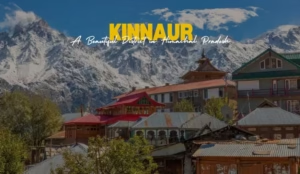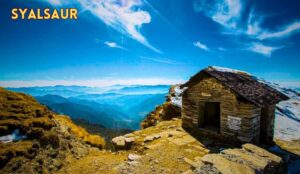“Explore the enchanting beauty of Benog Tibba 🏞️ in Mussoorie. Discover nature’s wonders in this hillside haven. 🌄 #BenogTibba”
About Benog Tibba:
Benog Tibba is a picturesque hill located near the charming hill station of Mussoorie in Uttarakhand, India. This serene and enchanting spot is nestled amidst the lush greenery of the Himalayan foothills, making it a haven for nature lovers and adventure enthusiasts. Here are some key points about Benog Tibba:
- Natural Beauty: Benog Tibba is celebrated for its natural beauty and tranquil atmosphere. It offers stunning panoramic views of the surrounding valleys and the majestic Himalayan peaks.
- Wildlife Sanctuary: It is a part of the Benog Wildlife Sanctuary, which is home to a diverse range of flora and fauna. This sanctuary is a paradise for birdwatchers and wildlife enthusiasts.
- Trekking Destination: Benog Tibba is accessible via a trekking trail that winds through dense forests and meadows. The trek offers an opportunity to immerse yourself in the pristine Himalayan wilderness.
- Benog Hill: The hill itself is covered with oak and deodar trees, adding to its scenic charm. It’s an excellent place for leisurely walks and picnics.
- Historical Significance: Benog Tibba also has a historical connection as it is believed to be the area where the great freedom fighter, Veer Chandra Singh Garhwali, took refuge during the British colonial period.
History of Benog Tibba:
The history of Benog Tibba is intertwined with the rich cultural and natural heritage of the Mussoorie region. Here are some historical highlights:
- Colonial Era: During the colonial era, Mussoorie and its surroundings were a popular retreat for the British. Benog Tibba, with its salubrious climate and lush landscapes, became a favored destination for them.
- Veer Chandra Singh Garhwali: One of the notable historical associations of Benog Tibba is with Veer Chandra Singh Garhwali, a prominent freedom fighter from the Garhwal region. It is said that he sought refuge in these hills during his struggle against British rule.
- Natural Heritage: Beyond its historical significance, Benog Tibba’s history is deeply intertwined with its natural heritage. The forests and wildlife of this region have been protected and conserved for generations, making it a vital part of Uttarakhand’s ecological history.
In summary, Benog Tibba is not only a place of breathtaking natural beauty but also a location with a rich historical background, offering visitors a chance to connect with both nature and history in the heart of the Himalayas.
Why is Benog Tibba Famous:
Benog Tibba has gained fame and popularity for several compelling reasons, making it a sought-after destination in the Mussoorie region. Here are the key factors that contribute to its fame:
- Scenic Beauty: Benog Tibba is renowned for its breathtaking natural beauty. The lush green hills, dense forests, and panoramic views of the Himalayan peaks captivate the hearts of nature enthusiasts and photographers.
- Wildlife Sanctuary: The hill is part of the Benog Wildlife Sanctuary, known for its rich biodiversity. It’s famous among wildlife lovers for the chance to spot various species of birds, including the Himalayan monal pheasant.
- Trekking Haven: Adventure seekers flock to Benog Tibba for trekking. The trekking trail leading to the hill offers an exhilarating experience through thick forests and meadows, making it a favorite among trekkers.
- Historical Significance: The hill holds historical importance as it is believed to have sheltered Veer Chandra Singh Garhwali, a prominent freedom fighter, during the struggle for India’s independence.
- Peace and Solitude: Benog Tibba is celebrated for its tranquility and peaceful ambiance. It provides an ideal escape from the hustle and bustle of city life, making it a famous retreat for those seeking serenity.
Things to Do in Benog Tibba:
Benog Tibba offers a range of activities and experiences that cater to various interests. Here are some of the top things to do in Benog Tibba:
- Trekking: Embark on a thrilling trek to Benog Tibba. The trekking trail takes you through dense forests, providing an opportunity to connect with nature and enjoy the stunning scenery.
- Bird Watching: Explore the Benog Wildlife Sanctuary and indulge in birdwatching. The region is a haven for bird enthusiasts, with a chance to spot colorful and rare avian species.
- Photography: Capture the mesmerizing landscapes, vibrant flora, and fauna through your camera lens. Benog Tibba offers incredible photography opportunities at every turn.
- Nature Walks: Enjoy leisurely nature walks amidst the serene surroundings. The hill is perfect for short hikes and picnics.
- Historical Exploration: Learn about the historical significance of Benog Tibba and its association with the freedom movement by visiting the areas of historical relevance.
- Relaxation: Unwind and meditate in the tranquil ambiance of Benog Tibba. It’s an excellent place to rejuvenate and find inner peace.
In conclusion, Benog Tibba’s fame is derived from its natural beauty, historical significance, and the diverse range of activities it offers, making it a well-rounded destination for travelers looking to connect with nature, history, and adventure.
Things to Know about Benog Tibba:
Benog Tibba is a captivating destination in the Mussoorie region, known for its natural beauty and historical significance. Here are essential things to know about this enchanting place:
- Location: Benog Tibba is situated near the hill station of Mussoorie, in the Indian state of Uttarakhand, amidst the picturesque Garhwal Himalayas.
- Elevation: The hill stands at an elevation of approximately 7,600 feet (2,316 meters) above sea level, offering panoramic views of the surrounding landscapes.
- Natural Beauty: It is celebrated for its lush greenery, dense forests of oak and deodar trees, and breathtaking views of the Himalayan peaks.
- Wildlife Sanctuary: Benog Tibba is part of the Benog Wildlife Sanctuary, a protected area known for its diverse flora and fauna, making it a paradise for birdwatchers.
- Trekking Destination: The hill is accessible via a trekking trail that meanders through serene forests and alpine meadows, providing an adventure for trekkers and nature enthusiasts.
- Historical Significance: Benog Tibba is associated with the historical figure Veer Chandra Singh Garhwali, who is believed to have sought refuge here during the Indian independence movement.
- Best Time to Visit: The ideal time to visit Benog Tibba is during the summer months, from April to June, when the weather is pleasant and conducive to trekking and sightseeing.
- Accommodation: Accommodation options are limited near Benog Tibba. Visitors often stay in Mussoorie, which offers a range of hotels, resorts, and guesthouses.
How to Reach Benog Tibba:
Getting to Benog Tibba requires planning and a journey to Mussoorie. Here’s how to reach this captivating destination:
- By Air: The nearest airport to Mussoorie is Jolly Grant Airport in Dehradun, approximately 60 kilometers away. From the airport, you can hire a taxi or take a bus to reach Mussoorie.
- By Train: The closest railway station to Mussoorie is Dehradun Railway Station, which is well-connected to major cities in India. From there, you can hire a taxi or take a bus to Mussoorie.
- By Road: Mussoorie is well-connected by road to cities like Delhi and Dehradun. You can drive or hire a taxi from these cities to reach Mussoorie.
- Local Transportation: Once in Mussoorie, you can hire a local taxi or use public transportation to get to the starting point of the Benog Tibba trek, which is usually near the Cloud’s End area.
- Trekking: The trek to Benog Tibba starts from Cloud’s End or Dhobi Ghat, both accessible from Mussoorie. The trail is well-marked, but it’s advisable to hire a local guide for a safe and enjoyable trekking experience.
In summary, Benog Tibba is a remarkable destination in the heart of the Himalayas, offering a blend of natural beauty and historical significance. To reach this serene hill, travelers typically arrive in Mussoorie first and then embark on a trekking adventure to Benog Tibba.
Travel Tips for Benog Tibba:
Visiting Benog Tibba requires some planning and preparation to make the most of your trip. Here are essential travel tips to consider:
- Acclimatization: Due to the higher altitude, it’s advisable to spend a day in Mussoorie or another nearby location to acclimatize before beginning the trek to Benog Tibba.
- Local Guide: Hiring a local guide is recommended for the trek. They can provide valuable insights, ensure your safety, and navigate the trail effectively.
- Pack Light: Carry only the essentials for your trek. Pack comfortable clothing, sturdy hiking boots, a raincoat, first-aid supplies, and a backpack with snacks and water.
- Permits: Check if any permits are required for trekking in the region. Ensure you obtain the necessary permits before starting your trek.
- Weather Conditions: Be prepared for changing weather conditions. Even during the summer, temperatures can drop, so bring layers of clothing to stay warm.
- Photography: If you’re a photography enthusiast, don’t forget to bring your camera. Benog Tibba offers stunning landscapes and opportunities for capturing memorable shots.
- Responsible Trekking: Follow Leave No Trace principles by not littering and respecting the environment. Dispose of trash properly and avoid disturbing wildlife.
- Emergency Contact: Share your itinerary and contact details with someone trustworthy in case of emergencies.
Best Time to Visit Benog Tibba:
Choosing the right time to visit Benog Tibba can greatly enhance your experience. Here’s when to plan your trip:
- Summer (April to June): This is the peak tourist season when the weather is pleasant, with daytime temperatures ranging from 15°C to 30°C (59°F to 86°F). It’s ideal for trekking and enjoying the natural beauty.
- Monsoon (July to September): The monsoon season brings heavy rainfall, which can make trekking trails slippery and challenging. It’s not the best time for outdoor activities, but the region looks lush and green.
- Autumn (October to November): Autumn offers clear skies and cool weather. It’s a great time for trekking as the trails are still accessible, and you can witness the vibrant fall foliage.
- Winter (December to March): Winter brings snowfall and cold temperatures, with daytime highs ranging from 0°C to 10°C (32°F to 50°F). Trekking during this season is not recommended for beginners due to harsh conditions.
In conclusion, plan your visit to Benog Tibba during the summer or autumn months for the best weather and trekking conditions. Ensure you follow travel tips for a safe and enjoyable experience in this beautiful Himalayan destination.
Places to Eat Near Benog Tibba:
While Benog Tibba itself may not have dining establishments, you can find several restaurants and eateries in nearby Mussoorie to satisfy your culinary cravings. Here are some options:
- Kalsang Friends Corner: This cozy Tibetan restaurant in Mussoorie is known for its delicious momos, thukpa, and other Tibetan specialties. It’s an excellent place for a quick and flavorful meal.
- Chic Chocolate: A popular cafe in Mussoorie, Chic Chocolate is famous for its delectable desserts, chocolates, and hot chocolate. It’s a sweet lover’s paradise.
- Lovely Omelette Centre: If you’re looking for a hearty breakfast or a quick snack, this iconic eatery in Mussoorie serves a wide variety of omelets with unique flavors.
- Café By The Way: This trendy cafe offers a diverse menu, including sandwiches, burgers, pasta, and coffee. It’s a great spot to relax and enjoy a leisurely meal.
- Kalsang Restaurant: Another Tibetan gem in Mussoorie, Kalsang Restaurant serves authentic Tibetan and Chinese dishes, including thenthuk, noodles, and more.
- Domino’s Pizza: If you’re craving familiar fast food, there’s a Domino’s Pizza outlet in Mussoorie where you can enjoy pizza and other fast-food options.
- Little Llama Café: This charming cafe is known for its cozy ambiance and serves a range of beverages, sandwiches, and baked goods. It’s an ideal place to unwind.
Nearby Places to Visit Around Benog Tibba:
Exploring the vicinity of Benog Tibba offers a range of attractions. Here are some nearby places worth visiting:
- Mussoorie: The famous hill station of Mussoorie is just a stone’s throw away from Benog Tibba. Explore Mall Road, visit Kempty Falls, or take a cable car ride to Gun Hill for panoramic views.
- Cloud’s End: This picturesque spot near Mussoorie is where the trek to Benog Tibba often begins. Enjoy the serene surroundings and pristine forests.
- Camel’s Back Road: This iconic road in Mussoorie is named after its natural rock formation resembling a camel’s back. It’s a lovely spot for a leisurely walk with scenic views.
- Company Garden: Located in Mussoorie, this well-maintained garden is perfect for a relaxed stroll amidst colorful flowerbeds and a mini lake with paddle boating.
- Lal Tibba: Known as the highest point in Mussoorie, Lal Tibba offers stunning panoramic views of the Himalayas. It’s a great place for sightseeing.
- Jwala Devi Temple: Situated in Mussoorie, this ancient temple dedicated to Goddess Durga is a revered religious site with a peaceful ambiance.
- Santura Devi Temple: Located near Mussoorie, this temple is perched atop a hill and offers both religious significance and beautiful views of the surroundings.
In conclusion, while Benog Tibba itself may not have dining options, nearby Mussoorie offers a range of eateries to satisfy your palate, and the surrounding area provides plenty of attractions to explore.
Conclusion:
Benog Tibba, nestled in the serene Himalayan foothills near Mussoorie, is a destination of natural beauty and historical significance. It offers lush green landscapes, dense forests, and stunning views of the Himalayan peaks. Trekking to Benog Tibba is a rewarding adventure, and the region’s biodiversity, including its role as part of the Benog Wildlife Sanctuary, makes it a paradise for nature enthusiasts and birdwatchers.
Visitors can also explore its historical connection to the Indian independence movement through its association with Veer Chandra Singh Garhwali. To make the most of your trip, plan for the right season, follow travel tips, and consider nearby attractions and dining options in Mussoorie.
FAQs (Frequently Asked Questions)
What is the best time to visit Benog Tibba?
-
- The best time to visit Benog Tibba is during the summer months (April to June) and autumn (October to November) when the weather is pleasant for trekking, sightseeing, and enjoying the natural beauty.
How do I reach Benog Tibba from major cities?
-
- To reach Benog Tibba, you can travel to Mussoorie first. The nearest airport is Jolly Grant Airport in Dehradun, and the nearest railway station is Dehradun Railway Station. From there, you can hire a taxi or take a bus to Mussoorie and then proceed to Benog Tibba.
Is Benog Tibba suitable for beginners in trekking?
-
- Benog Tibba’s trek is moderately challenging. While it may be suitable for beginners with a reasonable level of fitness, it’s advisable to have some prior trekking experience and to hire a local guide for safety and navigation.
Are there accommodation options near Benog Tibba?
-
- Accommodation options near Benog Tibba are limited. Visitors often stay in Mussoorie, which offers a range of hotels, resorts, and guesthouses to suit various budgets.
What are the main attractions near Benog Tibba besides trekking?
-
- Nearby attractions include Mussoorie’s Mall Road, Kempty Falls, Camel’s Back Road, Company Garden, and Lal Tibba. You can also explore historical temples like Jwala Devi Temple and Santura Devi Temple in the vicinity.





